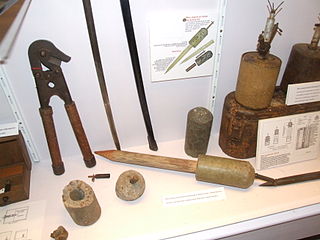Concrete mine

The concrete mine , or stick mine M43, is a German anti-personnel mine used in World War II , which owes its name to its concrete shell.
construction
Concrete mines consist of a cylindrical concrete shell that is interspersed with metal balls. In the middle of the cylinder is a cavity that contains the explosive, usually powder or TNT . At the top of the cylinder, above the explosive, is the detonator. The mines are mainly equipped with a pressure fuse that ignites the explosive device when loaded from above. Another possibility of igniting is the cross-linking. Tripwires are stretched between the individual detonators, which detonate several mines at the same time on contact.
The concrete mine also has an optional metal spur under the explosive device, which is why it is mainly known as the “stick mine”. This iron post is about as long as the mine itself (16 cm, together 32 cm) and has the diameter of the cylinder recess in the middle (total mine diameter 7 cm). It was used to ram the M43 quickly into the ground or as a digging tool.
production
In mass production, concrete and steel scrap were placed in a prefabricated shell made of impregnated cardboard. This saved metal, which was limited during wartime, and used concrete, an existing building material that was plentiful.
use
Concrete mines are mostly embedded in the earth up to the detonator, but there have also been uses above the earth's surface, e.g. B. as an anti-personnel mine with tripwire or as an explosive device with remote release. The mine is mostly ineffective against hard targets. It was only used against soft targets. Here she was fatal within a radius of up to 60 meters. It was used, among other things, in the Africa campaign and homeland security. Due to its heavy weight of over 2.26 kilograms (concrete casing + explosive device + metal spike + detonator), the mine was probably only used to secure already occupied areas.
function
A sharp M43 embedded or rammed into the earth detonates as follows upon contact with the fuse: The pressure pushes the metal spur downwards, which can lead to the mine “jumping”. The actual detonation thus takes place z. T. up to one meter above ground level. The explosive device tears up the concrete shell and shoots sharp-edged concrete splinters and the metal balls they contain like projectiles.
See also
literature
- Jane’s Mines and Mine Clearance 2005-2006
- Eddie Banks: Brassey's Essential Guide to Anti-Personnel Landmines
- W. Fleischer: Deutsche Landminen 1935-1945 , Podzun Pallas Verlag
- U.S. Army, Foreign Mine Warfare Equipment , TM 5-223
- H.DV. 220 / 4b - Training Regulations for Pioneers (AVPi.) Part 4b: Mines and mine detonators from September 10, 1944